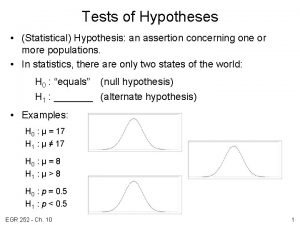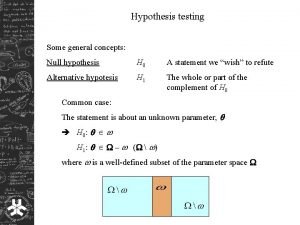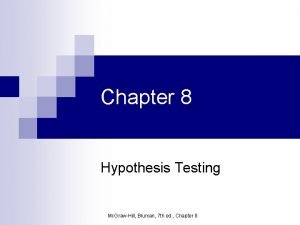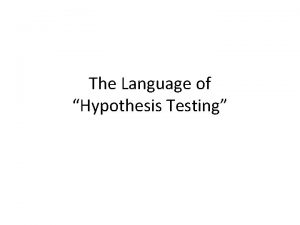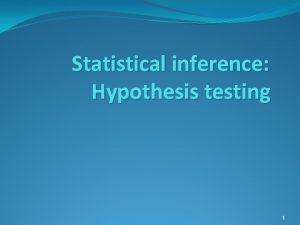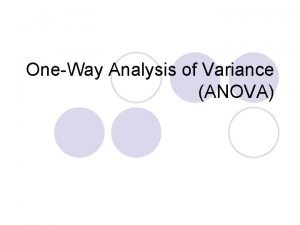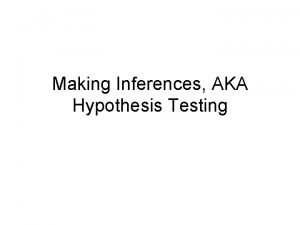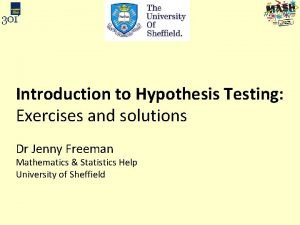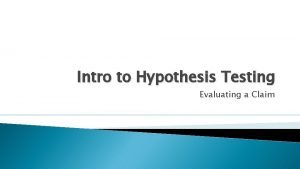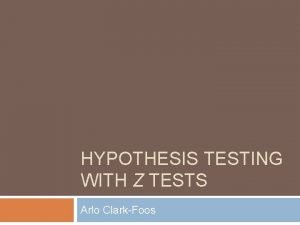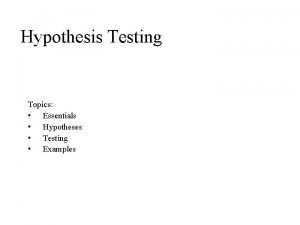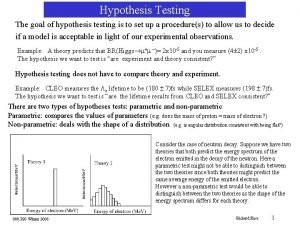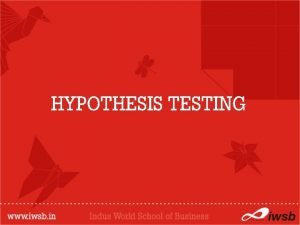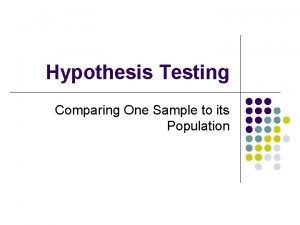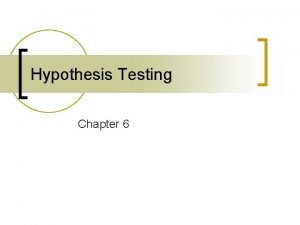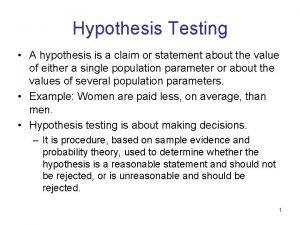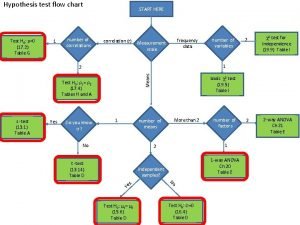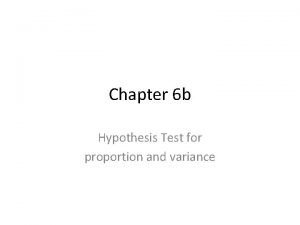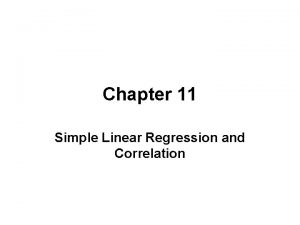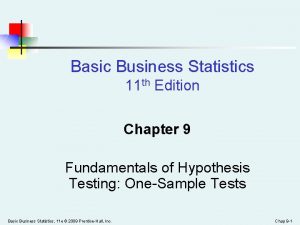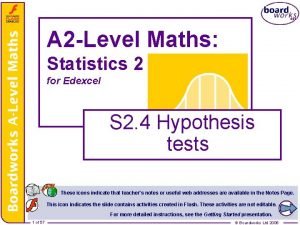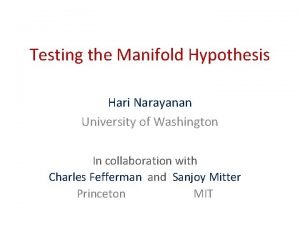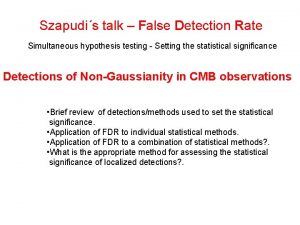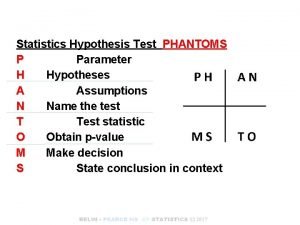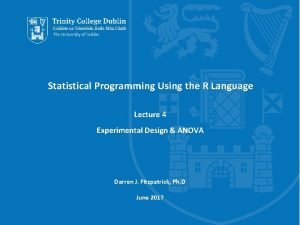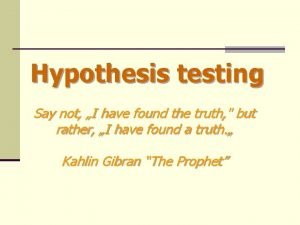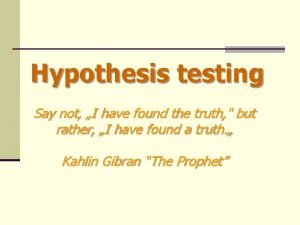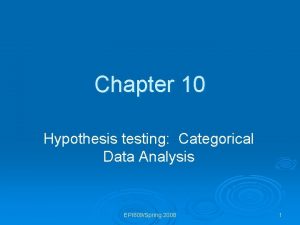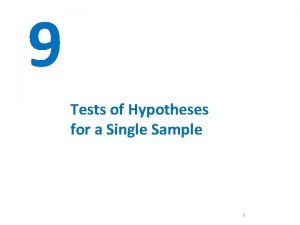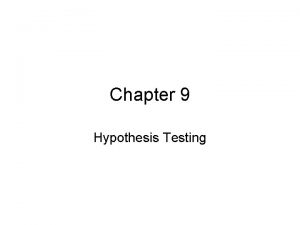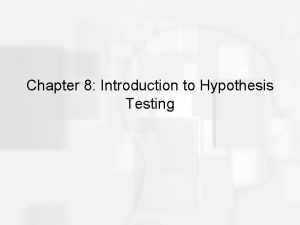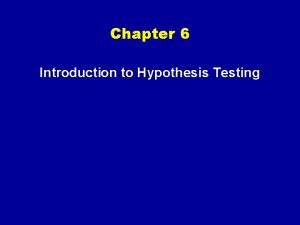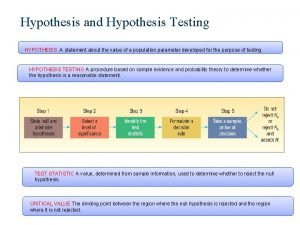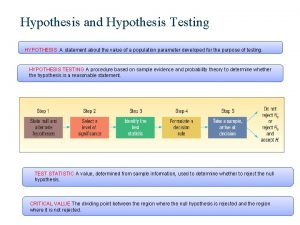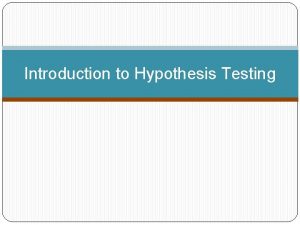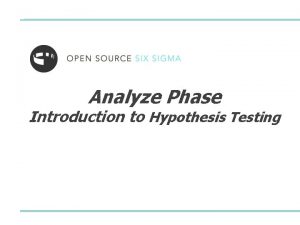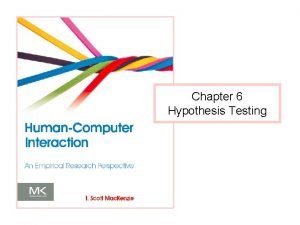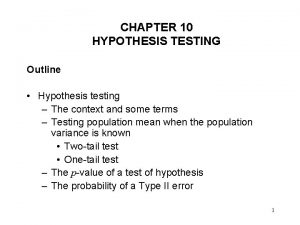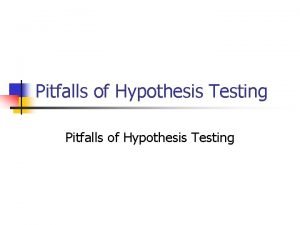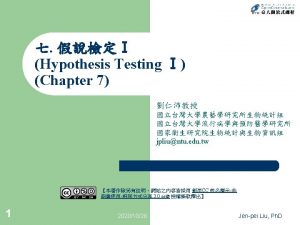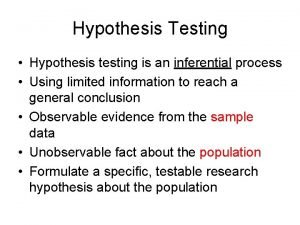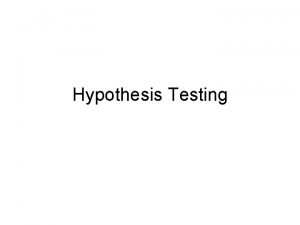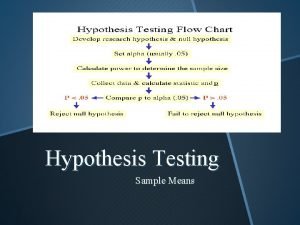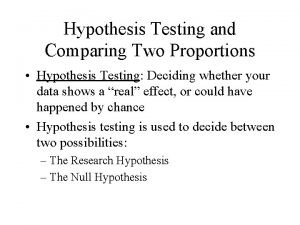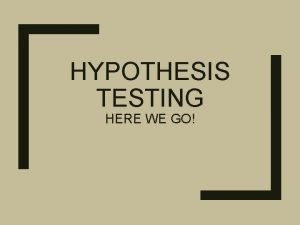Chapter 8 Introduction to Hypothesis Testing Hypothesis Testing




































- Slides: 36

Chapter 8: Introduction to Hypothesis Testing

Hypothesis Testing • An inferential procedure that uses sample data to evaluate the credibility of a hypothesis about a population. 2

Known population before treatment =4 µ = 18 T r e a t m e n t Unknown population after treatment =4 µ=? 3

Hypothesis Testing • Step 1: State hypothesis • Step 2: Set criteria for decision • Step 3: Collect sample data • Step 4: Evaluate null hypothesis • Step 5: Conclusion 4

• We know that the average GRE score for college seniors is µ = 500 and = 100. A researcher is interested in effect of the Kaplan course on GRE scores. • A random sample of 100 college seniors is selected and take the Kaplan GRE Training course. Afterwards, each is given the GRE exam. Average scores after training are 525 for the sample of 100 students. 5

Known population before treatment =100 µ = 500 T r e a t m e n t Unknown population after treatment = 100 µ=? 6

= 100 g µ = 500 g Step 1: Ho : µ = 500 (There is no effect of the Kaplan training course on average GRE scores) H 1 : µ 500 (There is an effect…) GRE after Kaplan Course = 0. 05 Critical Region z > 1. 96 or Step 2: Set criteria z < -1. 96 Step 3: n = 100 z 1. 96 X = 525 Step 4: Reject Ho because Zobt of 2. 5 is in the critical region. Step 5: Conclusion. The Kaplan training course significantly increased GRE scores on average, z = 2. 5, p <. 05. 7

Evaluating Hypotheses – Sampling Distribution Reject Ho Middle 95% Very Unlikely 480. 4 -1. 96 500 µ 0 519. 6 +1. 96 Very Unlikely X z 8

What is the effect of alcohol on fetal development? 9

Known population before treatment =4 µ = 18 T r e a t m e n t Unknown population after treatment =4 µ=? 10

=4 g µ = 18 g Step 1: Ho : (There is no effect of alcohol on the average birth weight of new born rat pups) µWeight of rats of= 18 g alcoholic mothers H 1 : µ 18 g (There is an effect…) Step 2: Set criteria Critical Region z > 2. 58 or z < -2. 58 Step 3: n = 25 rats = 0. 01 z 2. 58 X = 15. 5 g Step 4: Reject Ho because Zobt of -3. 125 is in the critical region. Step 5: Conclusion: Alcohol significantly reduced mean birth weight of newborn rat pups, z = 3. 125, p <. 01. 11

Reject Ho Very Unlikely 15. 936 -2. 58 Middle 99% 18 µ 0 Very Unlikely X 20. 064 +2. 58 z 12

The distribution of sample means (all possible experimental outcomes) if the null hypothesis is true Reject Ho Extreme values (probability < alpha) if Ho is true Possible, but “very unlikely”, outcomes 13

-1. 96 -2. 58 -3. 30 0 =. 05 =. 01 z 1. 96 2. 58 3. 30 =. 001 14

p> Reject Ho p< 15

What if the sample mean does not indicate a large enough change to reject the null? Step 1: Ho : µ = 500 (There is no effect of the Kaplan training course on average GRE scores) H 1 : µ 500 (There is an effect…) GRE after Kaplan Course = 0. 05 Critical Region z > 1. 96 or Step 2: Set criteria z < -1. 96 Step 3: n = 100 z 1. 96 X = 515 Step 4: Retain Ho because Zobt of 1. 5 is not in the critical region. Step 5: Conclusion. There was no effect of the Kaplan training on GRE scores on average, z = 1. 5, p >. 05. 16

What if the sample mean is not in the critical region? Step 1: Ho : (There is no effect of alcohol on the average birth weight of new born rat pups) µWeight of rats of= 18 g alcoholic mothers H 1 : µ 18 g (There is an effect…) Step 2: Set criteria Critical Region z > 2. 58 or z < -2. 58 Step 3: n = 25 rats = 0. 01 z 2. 58 X = 17 g Step 4: Retain Ho because Zobt of -1. 25 is not in the critical region. Step 5: Conclusion: There was no effect of alcohol on the average birth weight of newborn rat pups, z = 1. 25, p >. 01. 17

1. State hypothesis and set alpha level 2. Locate critical region • e. g. z > | 1. 96 | z > 1. 96 or z < -1. 96 3. Obtain sample data and compute test statistic 4. Make a decision about the Ho 5. State the conclusion 18

Actual Situation No Effect, Ho True Effect Exists, Ho False Reject Ho Type I Error Decision Correct Retain Ho Decision Correct Type II Error Experimenter’s Decision 19

Actual Situation Guilty Did Not Commit Crime Committed Crime Type I Error Verdict Correct Type II Error Jury’s Verdict Innocent 20

Actual Situation Your Decision Coin Fixed (Cheating) Coin O. K. (Fair) Coin Fixed (Cheating) Type I Error Correct Decision Type II Error 21

Assumptions for Hypothesis Tests with z-scores: 1. Random sampling 2. Value of unchanged by treatment 3. Sampling distribution normal 4. Independent observations 22

One-Tailed Hypothesis Tests 23

• A researcher wants to assess the “miraculous” claims of improvement made in a TV ad about a phonetic reading instruction program or package. We know that scores on a standardized reading test for 9 -year olds form a normal distribution with µ = 45 and = 10. A random sample of n = 25 8 -year olds is given the reading program package for a year. At age 9, the sample is given the standardized reading test. 24

Reject Ho Data indicates that Ho is wrong X 45 µ 0 z 1. 65 25

Two-tailed vs. One-tailed Tests 1. In general, use two-tailed test 2. Journals generally require two-tailed tests 3. Testing Ho not H 1 4. Downside of one-tailed tests: what if you get a large effect in the unpredicted direction? Must retain the Ho 26

Error and Power • Type I error = – Probability of a false alarm • Type II error = – Probability of missing an effect when Ho is really false • Power = 1 - – Probability of correctly detecting effect when Ho is really false 27

Factors Influencing Power (1 - ) 1. Sample size 2. One-tailed versus two-tailed test 3. Criterion ( level) 4. Size of treatment effect 5. Design of study 28

(a) Treatment Distribution Null Distribution =. 05 Reject Ho 1 - Reject Ho µ = 180 (b) X µ = 200 Treatment Distribution Null Distribution =. 01 Reject Ho 1 - µ = 180 µ = 200 X 29

Treatment Distribution (a) Null Distribution n = 25 Reject Ho 1 - Reject Ho µ = 180 Treatment Distribution X µ = 200 Null Distribution (b) n = 100 Reject Ho 1 - 180 200 X 30

Treatment Distribution Null Distribution Reject Ho 1 - Reject Ho X µ 180 µ 200 31

Treatment Distribution Null Distribution Reject Ho 1 - X µ 190 µ 200 32

Frequency 4 3 2 1 0 1 2 3 4 5 6 7 8 9 10 X 11 Frequency 4 3 2 1 0 1 2 3 4 5 6 7 8 9 10 11 X 33

Are birth weights for babies of mothers who smoked during pregnancy significantly different? µ = 2. 9 kg Random Sample: = 2. 9 kg n = 14 2. 3, 2. 0, 2. 2, 2. 8, 3. 2, 2. 5, 2. 4, 2. 1, 2. 3, 2. 6, 2. 0, 2. 3 34

The distribution of sample means if the null hypothesis is true (all the possible outcomes) Sample means close to Ho: high-probability values if Ho is true Extreme, low-probability values if Ho is true µ from Ho Extreme, low-probability values if Ho is true 35

Reject Ho Middle 95%: high-probability values if Ho is true Reject Ho z = 1. 96 z = -1. 96 µ from Ho Critical Region: Extreme 5% 36
 Hypothesis testing in statistics
Hypothesis testing in statistics Most powerful test
Most powerful test Chapter 8 hypothesis testing
Chapter 8 hypothesis testing Chapter 7 hypothesis testing with one sample answers
Chapter 7 hypothesis testing with one sample answers Hypothesis example
Hypothesis example Developing null and alternative hypothesis
Developing null and alternative hypothesis Null hypothesis examples
Null hypothesis examples Weakness of protoplanet hypothesis
Weakness of protoplanet hypothesis The language of hypothesis testing
The language of hypothesis testing Inference hypothesis testing
Inference hypothesis testing Gabriel welsch
Gabriel welsch Hypothesis testing assignment
Hypothesis testing assignment Hypothesis testing
Hypothesis testing Critical value hypothesis testing
Critical value hypothesis testing Hypothesis testing assumptions
Hypothesis testing assumptions Critical value hypothesis testing
Critical value hypothesis testing Goal of hypothesis testing
Goal of hypothesis testing Hypothesis testing meaning
Hypothesis testing meaning Null hypothesis test formula
Null hypothesis test formula Six steps of hypothesis testing
Six steps of hypothesis testing What is the claim in hypothesis testing
What is the claim in hypothesis testing Flow diagram of hypothesis testing
Flow diagram of hypothesis testing Hypothesis testing for population proportion
Hypothesis testing for population proportion Slope hypothesis testing
Slope hypothesis testing Business statistics hypothesis testing
Business statistics hypothesis testing Hypothesis testing a level maths
Hypothesis testing a level maths Sanjoy mitter
Sanjoy mitter Hypothesis testing in r
Hypothesis testing in r An insurance company checks police records on 582 accidents
An insurance company checks police records on 582 accidents Hypothesis testing in r
Hypothesis testing in r 2 way anova example
2 way anova example Hypothesis testing in excel
Hypothesis testing in excel Create a meme about concepts in hypothesis testing
Create a meme about concepts in hypothesis testing Hypothesis testing for variance
Hypothesis testing for variance Testing of hypothesis
Testing of hypothesis Categorical data hypothesis testing
Categorical data hypothesis testing Hypothesis statistics definition
Hypothesis statistics definition
